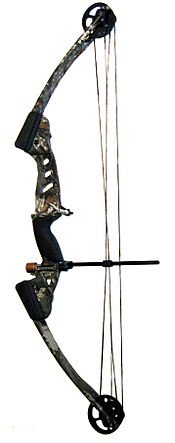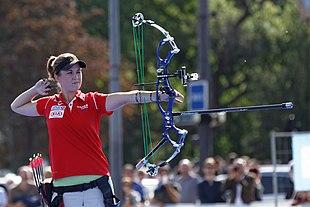
Back Arc de politges Catalan Compoundbogen German Arco de poleas Spanish Plokkvibu Estonian Arc à poulies French Arco compound Italian コンパウンドボウ Japanese 컴파운드 보우 Korean Skriemulinis lankas Lithuanian Compoundboog Dutch
This article has multiple issues. Please help improve it or discuss these issues on the talk page. (Learn how and when to remove these template messages)
|
| Compound bow | |
|---|---|
 | |
| Type | Bow and Arrow |

In modern archery, a compound bow is a bow that uses a levering system, usually of cables and pulleys, to bend the limbs.[1] The compound bow was first developed in 1966 by Holless Wilbur Allen in North Kansas City, Missouri, and a US patent was granted in 1969. Compound bows are widely used in target practice and hunting.
The pulley/cam system grants the user a mechanical advantage, and so the limbs of a compound bow are much stiffer than those of a recurve bow or longbow. This rigidity makes the compound bow more energy-efficient than traditional bows, as less energy is dissipated in limb movement. The higher-rigidity, more advanced construction also improves accuracy by reducing the bow's sensitivity to changes in temperature and humidity. In literature of the early 20th century, before the invention of compound bows, composite bows were described as "compound."[2]
- ^ Paterson, W. F. "Encyclopaedia of Archery". St. Martin's Press, 1984, p. 18.
- ^ Tutankhamun: Anatomy of an Excavation. (The notes were made in the 1920s and describe composite bows as "compound"; the modern compound bow did not exist at this time.) http://www.griffith.ox.ac.uk/gri/carter/135z.html
© MMXXIII Rich X Search. We shall prevail. All rights reserved. Rich X Search